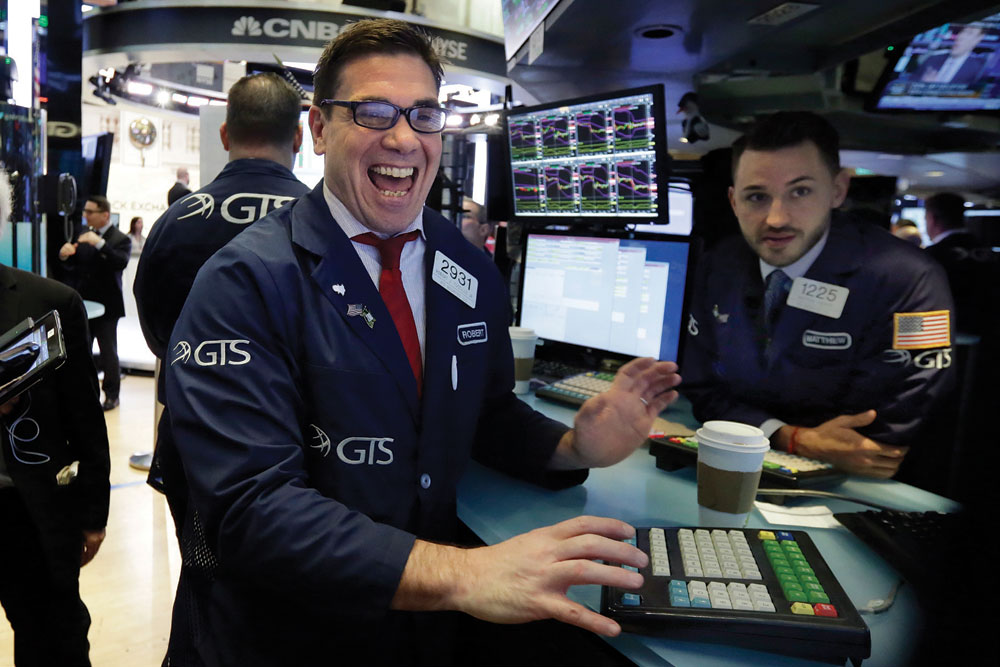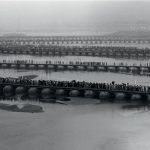Lost in the Noise
For a President who got so much wrong, Donald Trump got some important things just right
 Sudeep Paul
Sudeep Paul
 Sudeep Paul
Sudeep Paul
 |
30 Oct, 2020
|
30 Oct, 2020
/wp-content/uploads/2020/10/Lostinnoise1.jpg)
US President Donald Trump and Chinese President Xi Jinping at the Forbidden City in Beijing, November 2017 (Photo: AP)
Oh happy the man who still can hope
To rise again from this great sea of error,
What we do not know is the very thing we needed
And what we know we cannot use.
—Faust, Part One, Scene II
BETWEEN Eisenhower and Donald Trump, the best US presidents were Lyndon B Johnson, Richard Nixon and Ronald Reagan. Johnson was the Vietnam villain-in-chief and the hippies had screamed, “LBJ, LBJ, how many kids did you kill today?” The Texas Democrat was the president, albeit as a reluctant signatory, on whose watch the page was turned on civil rights. Yet, ‘Nam’ and the 1960s destroyed the most significant post-war president on social progress, as lamented in their mature years by many who had hit the shrill streets against him, forcing him to not seek re-election in 1968. Youth, indeed, is wasted on the young.
The Quaker Nixon is the most hated president. Or was, before we came to believe he was trumped circa 2020. Nixon, loathed with good reason in this part of the world, had learnt his lessons well as Eisenhower’s vice president, observing how America’s status as the sole economic superpower in a bipolar world could be leveraged. Nixon evolved into the arch-realist whose partnership with Henry Kissinger produced the most significant post-war foreign policy breakthrough. He also, technically, ended the bad war. Nixon and Kissinger, playing chequers and chess with Brezhnev and Mao, made America less reckless abroad, abandoned the ideological calculus in deal-making, and laid the ground for the institutionalisation of instrumentalism and incrementalism.
On Reagan fell the double burden of restoring confidence in the office after Nixon’s disgrace and of redeeming America after the disappointment called Jimmy Carter, who had bungled on the Iran hostage crisis and the Soviet invasion of Afghanistan. In partnership with Margaret Thatcher, Reagan gave the Western world its most conservative decade of the century. At home, he unleashed the ‘Reagan Boom’, an economic recovery that continued well into the 1990s. Abroad, Reagan was not a Nixonian realist. He abandoned caution but got away with it. And yet, America did not foresee the coming collapse of communism, beginning less than two years after Reagan left office.
THE current incumbent of the Oval Office walked into and out of the penumbra of these men. Whether Donald Trump left a legacy that could be pursued would depend, of course, on November 3rd. There’s less doubt whether Trump will leave a legacy that ought to be pursued—in part.
The argument of those who believe Trump got certain things right but won’t be around to see them through runs as journalist Yair Rosenberg tweeted last week, tongue-in-cheek: ‘…given the fundamentals, if Donald Trump was not Donald Trump he would be winning this election.’ Not in a long time has a president worked so persistently out of the box to overturn decades of misdirected and ossified policy abroad and yet have such a perceptively debilitating social impact at home. Never before did a president perform so well with the economy to see a near-civil war unleashed in the street.
Much of the ‘Trump boom’ had admittedly disappeared with the lockdown. But then began the recovery. The pandemic had cost about 22 million jobs. Since then, the economy has added back about 11 million. True, the other half of that 22 million is still jobless, but as Fed Chairman Jerome Powell has pointed out, people have been spending through the pandemic and even when unemployed. The pre-pandemic economy had run well enough to put enough money in their accounts. GDP, seasonally adjusted, is expected to bounce back at almost 32 per cent in the third quarter. The economy actually grew at 7.4 per cent in the third quarter and at an annual rate of 33.1 per cent, the biggest gain ever, when the numbers came out on October 29th. Mere numbers, but a marker nevertheless of a resilience that wouldn’t be evidenced if certain other things hadn’t gone right earlier.
The Economist, no fan of President Trump, says in a recent editorial: ‘Before covid-19, America enjoyed its lowest unemployment rate in 50 years, fast annual wage growth of almost 5% among the lowest-paid workers and a buoyant stockmarket.’ It adds: ‘Mr Trump attributes all this to his three-pronged strategy of tax cuts, deregulation and confrontational trade policy, and says more of the same will revive the economy after the pandemic. Many voters agree. The economy is one issue where Mr Trump does not face a big deficit in the polls.’ The editorial then lunges at what Trump got wrong: protectionism. Even as that argument goes, the President’s twin tools of ‘all-American’ and ‘pro-business’ made it “a great time to be an American worker” as Stephen Moore, Trump’s economic advisor during the 2016 campaign, would go on to say.
The 45th President understood the meaning of China. The trade war, much decried, has been the most important weapon in his arsenal. After Trump, will China resume getting away with everything as it did before?
In March 2016, Michael Goldfarb had argued that to understand why Trump stood a real chance of winning, one had to go back four decades to the still-inhabited ghost towns of de-industrialised America (‘The 40-Year Hurt’, bbc.com). Goldfarb wrote, rather eloquently: ‘How much does it hurt to leave the certainty in which you were raised, the community of family and church and friends who have known you forever? …You find a job, but unlike your daddy’s job it isn’t unionised, you work for less and you have very little security. When the economy slows, you know your job is at risk. America grows richer for some but not for you. That hurts.’ NAFTA-destroyed America had voted for Trump in the red states and swing states, punishing Hillary Clinton for an FTA that was her husband’s doing. Some of these would be the ‘deplorables’, no doubt. But if 2020 were fought only on the economy, some of the reportedly once-46 per cent Black approval for Trump vis-à-vis the economy could have translated into votes. As Americans surveyed across race and class tend to say: the Trump years had been good for them (till the pandemic) as individuals, but not for America.
The economy growing at almost double the Obama years (below 2 per cent) would itself be the story. But what made the difference may be gleaned from two facts: One, rise in wages. From the highest of $26 in inflation-adjusted average hourly income at the end of the Obama presidency in 2016, it peaked at $30 under Trump before the pandemic. Wages fell with the lockdown but had climbed back to $29.4 by August this year. And, what makes a big difference in blue-collar jobs, bonuses increased. Two, if averages don’t show where the money is going, and even as inequality increased in America, poverty fell to an all-time low of 10.5 per cent when it had been at 15 per cent around 2010 , as per data from the US labour and census bureaus. Trump can hardly take credit for all of it. But unleashing America’s entrepreneurial energies and getting the jobs back was him. Whether it would have sustained itself long-term we may never know.
THERE is more credibility to Trump’s self-positioning as an ‘outsider’ in foreign policy. It needed an outsider to break with the pursuit of ‘liberal hegemony’ institutionalised by the Clinton administration in the aftermath of the Soviet collapse. Trump has blown hot and cold on Russia to the extent that real intent and mere signalling became indistinct. Trump ordered the Syria pullout, in an apparent victory for neorealists who wanted the US out of the Middle East, but took out Qasem Soleimani, scrapped the nuclear deal and sanctioned Iran. He has inconsistently (who can blame him when Pyongyang is at the other end of the line?), but persistently, tried to do a deal with Kim Jong-un. He upgraded defence and security ties with India; backed the resurrection of the Quad as early in his term as 2017; asked European and Asian allies to pick up the tab (he wasn’t the first US president to desire it, but the first to not mince his words in demanding so—something that aims to help US manufacturers too); and blessed deal after deal between Israel and Muslim states. Above all, his administration understood the military threat from China right before Chairman Xi finally jettisoned the hogwash of ‘peaceful rise’ that Beijing had sheltered behind for four decades. In the intersection of foreign policy and geopolitics, Donald Trump has been, in many ways, a president without precedent.

Jerusalem was recognised as the capital of the State of Israel by Congress in 1995 and had become a public law (the Jerusalem Embassy Act). The Trump administration’s decision to shift the US Embassy, after two-plus decades and three presidents sitting on it, was met with international condemnation, the fact being lost that, whether on a single- or a two-state roadmap, Jerusalem, at least a half of it, would remain the capital of Israel. (The real controversy is that the embassy straddles the Green Line.) And what has Trump achieved that no president before him managed? When Israel and Sudan made peace last week, journalist Arsen Ostrovsky tweeted: ‘It took #Israel 72 years to make peace with 3 Arab countries. Today’s deal with #Sudan is the 3rd peace deal in just *72days*!’ An apt summary. Under three months, Trump has brokered normalisation of relations between Israel and the UAE, Bahrain, Kosovo and now Sudan. The Sudan deal would seal Trump’s legacy in the region, notwithstanding—that’s the man again—the crudeness of his alleged attempt to get Israeli Prime Minister Binyamin Netanyahu to admit how this couldn’t have come from another US president.
The riskiest and boldest of moves was North Korea. America had tried the carrot-and-stick before, but Trump indicated he was prepared to do a bit more. The world’s most dangerous rogue state with nukes and missiles had reached a point where it had rapidly exhausted its options and pushed things to a point of no return. It would likely deal. Trump pounced on it, believing it was time to blunt the fangs for good. But North Korea being North Korea, it would have taken more than one presidential term, if not
another Kim.
In Trump’s four years, the US was not drawn into or made to start a new war. Trump is not labelled a realist by strategic wonks but the moralistic impulse disappeared from foreign policy. Whether that’s a good thing or bad would depend, normally, on its consequences. But after nearly three decades of liberal crusade—which couldn’t salvage even the necessary war in Afghanistan—somebody had to pull back. Steve Hilton, the host of The Next Revolution on Fox News may have exaggerated (‘Trump’s foreign policy greatest of any president since WWII’), but wasn’t that off the mark. Drawing down without retrenching—that’s what Trump evidently began. To signal that an America in decline was retrenching would have been calamitous. Trump pulled out and pushed in as needed. The result was a strategic rebalancing of America’s equations with friends and foes.
If 2020 were fought only on the economy, Trump would still get a walkover. Before the pandemic, the US saw its lowest unemployment rate in 50 years. Wages for the lowest-paid grew, bonuses increased. And poverty fell to an all-time low of 10.5 per cent while stocks boomed
MUCH of what Trump has done comes back to China. At the crossroads of geopolitics and geoeconomics, China is the biggest thing the 45th presidency grasped the meaning of. The trade war, much decried, has been the most important weapon in the arsenal of a Washington with eyes wide open for the first time.
Roger Faligot’s Chinese Spies: From Chairman Mao to Xi Jinping—on how deep Beijing’s espionage runs—is an important book from last year. An equally, if not more, important book has come out this year—Clive Hamilton and Mareike Ohlberg’s Hidden Hand: Exposing How the Chinese Communist Party Is Reshaping the World. Hamilton and Ohlberg’s scope is vast but limited to the Western world (North America, Western Europe and Australia). On the one hand, the book maps the ambitions of the Communist Party of China (CPC) and shows, with evidence at every step, how each individual, institution and organisation with Chinese links, no matter how tenuous, informal or innocuous, in the West is actually a front for the Party (the United Front Work Department or the PLA). On the other, it exposes how Beijing has worked its way into the minds and pockets of people who matter—presidential candidates, Congressmen, MEPs, MPs, ambassadors, industrialists, journalists, et al. (Remember Clinton’s Chinagate of 1996? And yes, the Bush, Biden and Trump families are all there in this story.) The ‘CCP’s influence, interference and subversion in North America and Western Europe’ also uses intimidation—against Chinese citizens abroad, people of Chinese origin with family ties to China, and American and European citizens who irritate the Party: tweets irking Beijing have actually cost people their jobs. Many never know they are unwitting enablers of the CPC. In any case, Beijing always begins by extensively studying the ‘elite power map’ in a country, identifying friends and enemies, and then making its approach.
Part of this strategy, extending Mao’s ‘surround the city with the countryside’ on the grandest scale, is to shower dimes on poor, de-industrialised small towns across the geography of the US (a similar thing is happening in the poorer former East Germany), enticing their grateful mayors and residents, and cornering local and national politicians who might think differently with ‘public opinion’, which is also let loose upon the national capital (the city). China, thus, is perceived as benign and necessary, the narrative built up and legitimised as much from the bottom up as from the top down. (‘Sinophobia’, too, is a concoction, brewed diligently, by the Party.)
The Trump administration threw the first spanner in Beijing’s works. Nixon’s détente can be retrospectively blamed today for China’s aspirations for Weltmacht. But that’s the cynicism of hindsight and it turns the definition of ‘realism’ on its head. On both trade and its maritime adventurism, Beijing has found itself checked. An increasingly sceptical Europe, fearing entrapment, is hesitating on the Belt and Road, the one project that would lock half the world into Beijing’s client system. In Hamilton and Ohlberg’s eyes, ‘While he is wrong on many other things, Trump is right that Beijing has been systematically violating the principles of international economic engagement and getting away with it.’ However, Trump didn’t get it right from the start: he ‘zigzagged’ through 2017 and 2018 before settling into ‘a permanently hard position in 2019’.
China’s military aggression and Xi’s exhortations for war-readiness may be partly a reaction to feeling the heat for the first time since 1989. Or it may be the evolution of strategy as seen by Xi’s hardliners. The pandemic may have battered Trump more than China—and Beijing, after the initial beating it took, perhaps considers it a boon. The question is: after Trump, will China resume getting away with everything as it did before?
Johnson, Nixon and Reagan. Figures of hate. Two through their terms and thereafter. The third quickly found his way into the hall of infamy with the reinvention of the left when history did not end. And history vindicates them, in large part, every day. How will it judge Donald Trump? And how can we use what we do know?

/wp-content/uploads/2025/01/Cover_Kumbh.jpg)












More Columns
The lament of a blue-suited social media platform Chindu Sreedharan
Pixxel launches India’s first private commercial satellite constellation V Shoba
What does the launch of a new political party with radical background mean for Punjab? Rahul Pandita